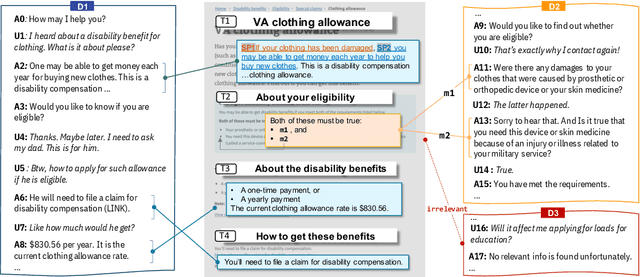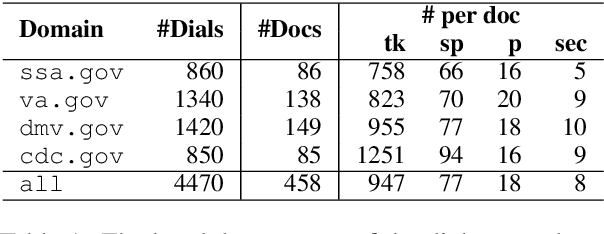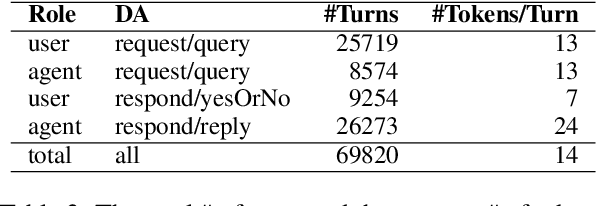Luis A. Lastras
API-BLEND: A Comprehensive Corpora for Training and Benchmarking API LLMs
Feb 23, 2024Abstract:There is a growing need for Large Language Models (LLMs) to effectively use tools and external Application Programming Interfaces (APIs) to plan and complete tasks. As such, there is tremendous interest in methods that can acquire sufficient quantities of train and test data that involve calls to tools / APIs. Two lines of research have emerged as the predominant strategies for addressing this challenge. The first has focused on synthetic data generation techniques, while the second has involved curating task-adjacent datasets which can be transformed into API / Tool-based tasks. In this paper, we focus on the task of identifying, curating, and transforming existing datasets and, in turn, introduce API-BLEND, a large corpora for training and systematic testing of tool-augmented LLMs. The datasets mimic real-world scenarios involving API-tasks such as API / tool detection, slot filling, and sequencing of the detected APIs. We demonstrate the utility of the API-BLEND dataset for both training and benchmarking purposes.
Pointwise Mutual Information Based Metric and Decoding Strategy for Faithful Generation in Document Grounded Dialogs
May 20, 2023



Abstract:A major concern in using deep learning based generative models for document-grounded dialogs is the potential generation of responses that are not \textit{faithful} to the underlying document. Existing automated metrics used for evaluating the faithfulness of response with respect to the grounding document measure the degree of similarity between the generated response and the document's content. However, these automated metrics are far from being well aligned with human judgments. Therefore, to improve the measurement of faithfulness, we propose a new metric that utilizes (Conditional) Point-wise Mutual Information (PMI) between the generated response and the source document, conditioned on the dialogue. PMI quantifies the extent to which the document influences the generated response -- with a higher PMI indicating a more faithful response. We build upon this idea to create a new decoding technique that incorporates PMI into the response generation process to predict more faithful responses. Our experiments on the BEGIN benchmark demonstrate an improved correlation of our metric with human evaluation. We also show that our decoding technique is effective in generating more faithful responses when compared to standard decoding techniques on a set of publicly available document-grounded dialog datasets.
DG2: Data Augmentation Through Document Grounded Dialogue Generation
Dec 15, 2021



Abstract:Collecting data for training dialog systems can be extremely expensive due to the involvement of human participants and need for extensive annotation. Especially in document-grounded dialog systems, human experts need to carefully read the unstructured documents to answer the users' questions. As a result, existing document-grounded dialog datasets are relatively small-scale and obstruct the effective training of dialogue systems. In this paper, we propose an automatic data augmentation technique grounded on documents through a generative dialogue model. The dialogue model consists of a user bot and agent bot that can synthesize diverse dialogues given an input document, which are then used to train a downstream model. When supplementing the original dataset, our method achieves significant improvement over traditional data augmentation methods. We also achieve great performance in the low-resource setting.
doc2dial: A Goal-Oriented Document-Grounded Dialogue Dataset
Nov 18, 2020



Abstract:We introduce doc2dial, a new dataset of goal-oriented dialogues that are grounded in the associated documents. Inspired by how the authors compose documents for guiding end users, we first construct dialogue flows based on the content elements that corresponds to higher-level relations across text sections as well as lower-level relations between discourse units within a section. Then we present these dialogue flows to crowd contributors to create conversational utterances. The dataset includes about 4800 annotated conversations with an average of 14 turns that are grounded in over 480 documents from four domains. Compared to the prior document-grounded dialogue datasets, this dataset covers a variety of dialogue scenes in information-seeking conversations. For evaluating the versatility of the dataset, we introduce multiple dialogue modeling tasks and present baseline approaches.
Lattice Representation Learning
Jun 24, 2020



Abstract:In this article we introduce theory and algorithms for learning discrete representations that take on a lattice that is embedded in an Euclidean space. Lattice representations possess an interesting combination of properties: a) they can be computed explicitly using lattice quantization, yet they can be learned efficiently using the ideas we introduce in this paper, b) they are highly related to Gaussian Variational Autoencoders, allowing designers familiar with the latter to easily produce discrete representations from their models and c) since lattices satisfy the axioms of a group, their adoption can lead into a way of learning simple algebras for modeling binary operations between objects through symbolic formalisms, yet learn these structures also formally using differentiation techniques. This article will focus on laying the groundwork for exploring and exploiting the first two properties, including a new mathematical result linking expressions used during training and inference time and experimental validation on two popular datasets.
Information Theoretic Lower Bounds on Negative Log Likelihood
Apr 12, 2019

Abstract:In this article we use rate-distortion theory, a branch of information theory devoted to the problem of lossy compression, to shed light on an important problem in latent variable modeling of data: is there room to improve the model? One way to address this question is to find an upper bound on the probability (equivalently a lower bound on the negative log likelihood) that the model can assign to some data as one varies the prior and/or the likelihood function in a latent variable model. The core of our contribution is to formally show that the problem of optimizing priors in latent variable models is exactly an instance of the variational optimization problem that information theorists solve when computing rate-distortion functions, and then to use this to derive a lower bound on negative log likelihood. Moreover, we will show that if changing the prior can improve the log likelihood, then there is a way to change the likelihood function instead and attain the same log likelihood, and thus rate-distortion theory is of relevance to both optimizing priors as well as optimizing likelihood functions. We will experimentally argue for the usefulness of quantities derived from rate-distortion theory in latent variable modeling by applying them to a problem in image modeling.
 Add to Chrome
Add to Chrome Add to Firefox
Add to Firefox Add to Edge
Add to Edge